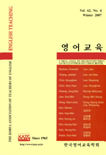Classroom Motivation of Korean EFL Students from the Perspective of Self-determination Theory
Classroom Motivation of Korean EFL Students from the Perspective of Self-determination Theory
- 한국영어교육학회
- ENGLISH TEACHING (영어교육)
- ENGLISH TEACHING Vol.62 No.4
-
2007.12391 - 409 (19 pages)
- 289

Autonomous motivation and its influence on classroom achievement has been the subject of much research within both educational psychology and second language learning. This study used the principles of self-determination theory (SDT), and the basic concepts of intrinsic-extrinsic motivation, to examine the motivational patterns of 167 middle school students studying English as a Foreign Language (EFL) in Seoul, Korea. The following research questions were addressed: (1) What are the motivational patterns of these students from an SDT perspective, and how do they compare with similar populations in other countries? (2) What is the correlation between these motivational patterns and these students" classroom achievement in studying English? The Self-Regulation Questionnaire- Academic (SRQ-A), was administered to these participants, and results were correlated with their record of classroom achievement in EFL. Data were subjected to quantitative analysis, and findings indicated that the highest level of motivation for these students was at the extrinsic level of identified regulation, but that the highest level of classroom achievement was attained by those students who were motivated intrinsically. Data from studies done in other countries reflected similar motivational profiles. The study concluded with a discussion of limitations and classroom implications.
Ⅰ. INTRODUCTION<BR>Ⅱ. SELF-DETERMINATION THEORY AND SECOND LANGUAGE LEARNING<BR>Ⅲ. METHOD<BR>Ⅳ. DISCUSSION<BR>Ⅴ. CONCLUSIONS, STUDY LIMITATIONS, AND CLASSROOM IMPLICATIONS<BR>REFERENCES<BR>APPENDIX A<BR>
(0)
(0)